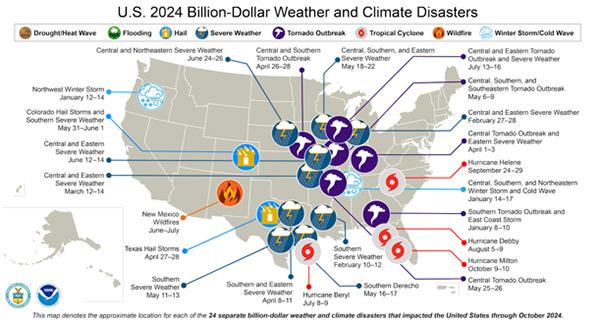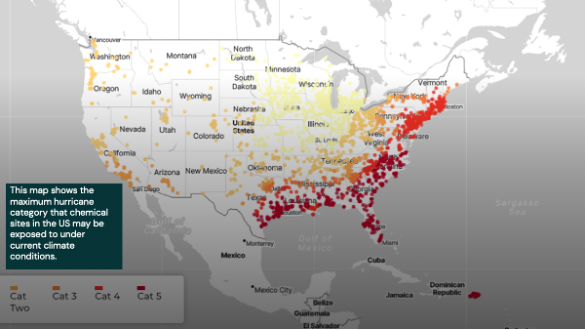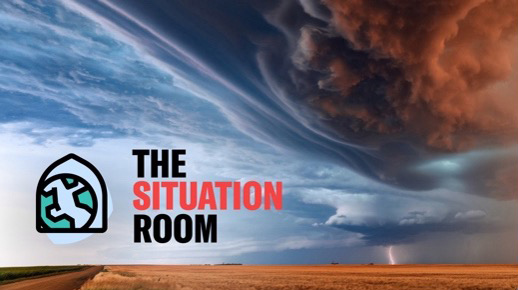Discover strategies to boost safety, build resilience, and turn readiness for climate challenges into opportunities for stronger operations.
By David Picton, Senior VP ESG & Sustainability
The North American 2024 hurricane season set new benchmarks for intensity and destruction, underscoring the urgent need for businesses to tackle escalating climate risks with proactive strategies. Hurricanes like Helene, which caused an unprecedented $60 billion in damages, disrupted global supply chains and upended communities far beyond coastal areas, have proven that resilience – encompassing operational stability, financial durability and reputational safeguarding – is no longer optional for organizations. Moreover, hurricanes are just one of the challenges from intensifying climate risks – the recent devastating and tragic Californian wildfires were also inextricably linked to a changing climate. Companies that fail to adapt to these escalating risks may find themselves unprepared for the next crisis, while those that integrate safety and sustainability practices into their operations can better navigate challenges and even uncover opportunities.

The devastation from Hurricane Helene extended beyond immediate physical damages. Inland manufacturing hubs, once considered safe from storms, faced unprecedented disruptions, forcing businesses to confront vulnerabilities they had previously overlooked. For small and medium-sized enterprises (SMBs), the impact was especially severe. With thinner margins and fewer resources, SMBs struggled to recover quickly, leaving them vulnerable to prolonged operational disruptions.
In 2024, insured losses from natural catastrophes, including hurricanes, exceeded $135 billion globally, highlighting the financial stakes for businesses unprepared for climate risks. The Atlantic hurricane season alone accounted for approximately $200 billion in total economic losses, making it one of the costliest on record. (WSJ; NY Post)
Many organizations still approach disaster preparedness as a standalone initiative, often siloed within specific departments. Yet, climate risks like hurricanes don’t impact businesses in isolation; they ripple across operations, supply chains and workforces. Without a comprehensive strategy that integrates safety and sustainability, companies risk not only financial losses but also long-term reputational damage, significant operational disruption and potentially even risks to the safety of their people.
The concept of resilience goes beyond weatherproofing facilities or having an emergency response plan. It’s about embedding adaptability into the organizational DNA to anticipate, withstand and recover from disruptions—be they natural disasters, supply chain challenges, or regulatory changes.
For example, diversifying supply chains to reduce geographic dependencies can mitigate risks from localized disasters. Similarly, investing in renewable energy solutions not only supports ESG (environmental, social, and governance) goals but also ensures operations can continue during power outages. These actions don’t just prepare businesses for extreme weather; they make organizations more competitive and better positioned for future challenges.
At the core of resilience is the integration of safety and ESG principles. When these frameworks are aligned, they create a holistic approach to managing risks while driving operational efficiency. Consider chemical management systems: these tools ensure compliance with safety regulations, reduce environmental impact and minimize health risks for employees. During crises like hurricanes, having such systems in place can mean the difference between a contained incident and a catastrophic spill.
Investors are increasingly drawn to companies that demonstrate proactive risk management and sustainability. Transparent ESG reporting signals accountability, which builds trust among stakeholders. For customers, ESG-aligned practices reflect a company’s values, enhancing brand loyalty.
The challenges of this year’s hurricane season provide a roadmap for businesses to strengthen their resilience in 2025 and beyond. Three key lessons stand out:
This year’s hurricanes also underscored the unpredictable nature of storm paths and intensities, with several storms defying forecasts and rapidly intensifying. For example, Hurricane Milton rapidly intensified into a Category 5 hurricane, with a significant pressure drop in just 7 hours making it the most rapidly intensifying hurricane in nearly 20 years. Businesses need to remain agile in their planning, ensuring that preparedness strategies account for these shifting patterns. (NY Post)

Resilience is not a solo endeavor. Businesses, governments, and communities must work together to develop shared solutions. Public-private partnerships can create regional risk assessment tools or community-based emergency response programs that benefit all stakeholders. By pooling resources and expertise, organizations can amplify their impact, protecting both economic interests and societal well-being.
While the increasing frequency and severity of hurricanes pose undeniable challenges, they also present opportunities for forward-thinking businesses to differentiate themselves. By adopting a proactive approach to resilience, companies can:
To build a weather-resistant workplace, businesses should:
As climate risks continue to escalate, the time for action is now. The 2024 hurricane season has shown that resilience is no longer just a buzzword; it’s a business imperative. Companies that embrace safety and sustainability as integral to their operations will not only weather future storms but also position themselves for long-term success in an increasingly uncertain world.
By embedding resilience into their DNA, businesses can transform today’s challenges into tomorrow’s opportunities, ensuring they thrive no matter what storms lie ahead.


About the Author:
David Picton is the senior vice president of ESG and sustainability for EcoOnline Global, a provider of EHSQ software solutions. The Situation Room is EcoOnline Global’s LinkedIn newsletter that discusses climate-driven hazards and explores how businesses can prepare and respond to them.
Read more from the author:
EHS Today, Weather-resistant Workplace Resilience – November 20, 2024
Net Zero – What Is All The Fuss About? | EcoOnline – June 23, 2023
In this episode, I sat down with Beejan Giga, Director | Partner and Caleb Emerson, Senior Results Manager at Carpedia International. We discussed the insights behind their recent Industry Today article, “Thinking Three Moves Ahead” and together we explored how manufacturers can plan more strategically, align with their suppliers, and build the operational discipline needed to support intentional, sustainable growth. It was a conversation packed with practical perspectives on navigating a fast-changing industry landscape.